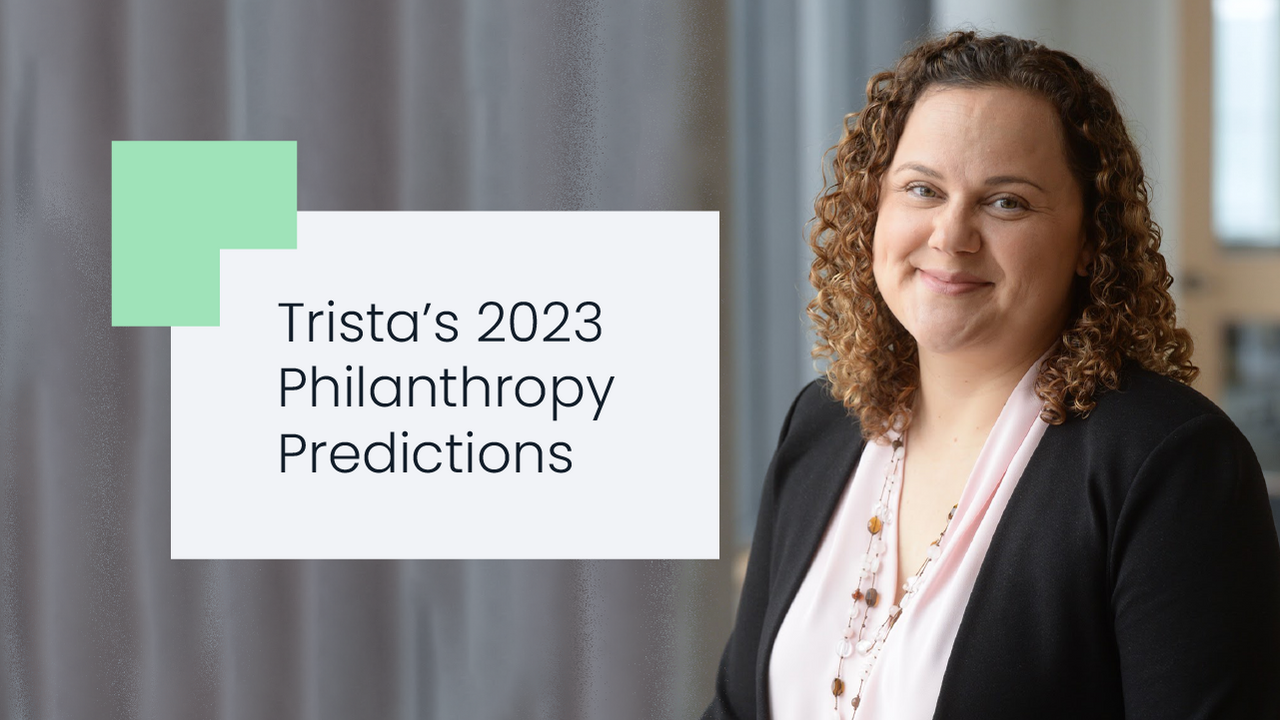
Trista’s 2023 Philanthropy Predictions
Dec 05, 2022Every year Trista Harris and the FutureGood team develop a series of predictions that will impact the social sector. Past predictions have included nonprofits giving up permanent office space, the growth of universal basic income, and the shifting demographics of foundation boards. But this moment in time is calling for a different set of trends. We are living in a time of rapid transformation in the philanthropic field. The pandemic, racial reckoning and economic instability are accelerating the already fast pace of change. In 2016, we were starting the feel the acceleration of change in philanthropy and created a future of philanthropy model. Because of this rapid pace of change we are now living in that future. So here are my predictions of what is coming next for the field. I expect these trends to be widespread by 2032.
Philanthropy as a Collaborator
In this future, philanthropy lives up to Paul Ylvisaker's notion of philanthropy as society’s passing gear. The promise of philanthropy being the testing ground for innovative ideas that are scaled by the government is realized through strategic collaborations and purposeful bureaucratic systems like Michigan’s Governor’s Office of Foundation Liaison.
Philanthropy deepens its role in civic engagement by supporting nonprofits that are working on solving community issues through advocacy and organizing. There will be more of a focus on how we are solving issues rather than using philanthropic dollars to just make things 5% less terrible.
Regenerative Philanthropy Takes Root
Justice Funders has developed a comprehensive model of what a transition from extractive to regenerative philanthropy should look like. A few highlights that I think will deeply impact the future of philanthropy:
- Authentic partnerships with grantees where communities impacted by the problem design solutions to those problems.
- Less time on due diligence processes and more on relationship building.
- An increased focus on transferring foundation resources away from the hands of a few donors towards communities that have been hurt by wealth extraction.
Seeing Past the Grants
During the pandemic and economic downturn foundations have been paying a lot more attention to how their full operations impact the communities that they care about. We will continue to see an operationalization of a foundation’s values through all aspects of their functions. A few examples of what this will look like in action:
- More foundation will move their investment strategy screens from not investing in harmful things like tobacco or for-profits prisons to improvement of the issues they care about, i.e. carbon mitigation.
- A large percentage of foundations will have (and use) diverse vendor policies for their spending decisions, ensuring that foundation resources are spending more time in local communities and benefiting marginalized communities.
- HR departments will interrogate their hiring practices to better understand where biases live within their practices and will rebuild those processes.
- We will move towards a future where 100% of foundation assets are mission and program related invested. This infusion of new dollars into social purpose capital markets will create new opportunities for the development of things like affordable housing and lower interest rate loans for entrepreneurs of color.
Artificial Intelligence Makes a Noticeable Impact
Dr. Ray Kurzweil has predicted that Artificial Intelligence (AI) will achieve human-like intelligence before 2029. This has vast impacts for nonprofits, foundations, and society as a whole. We will need to quickly learn how to partner with AI to improve the way we work. While some worry about AI replacing white collar workers, we think it is more realistic that we will use AI in the social sector to take over routine tasks and reporting and will use the creativity of humans to strengthen the impact of our organizations. In this future a nonprofit could give permission to a system like Jasper AI to create a grant application on their behalf using publicly available information about the organization.
Invest in leaders, not just organizations
In the future of philanthropy there will be a clear understanding that healthy, balanced nonprofit (and foundation) leaders are able to create better outcomes for communities. Foundations will invest in long-term relationships with nonprofit leaders so that grantees trust that they can take risks and make big bets. Investing in sabbaticals and grantee learning will be a regular occurrence throughout the field.
The field of philanthropy is changing at an exponential pace. We can use this moment of transformation to ensure that the field is working to create a more beautiful and equitable future.
About: Trista Harris is a philanthropic futurist and nationally known as a passionate advocate for leaders in the philanthropic and nonprofit sectors. She is also the author of the books How to Become a Nonprofit Rockstar and FutureGood: How to Use Futurism to Save the World. She is a President of FutureGood, a consultancy focused on helping visionaries build a better future.

